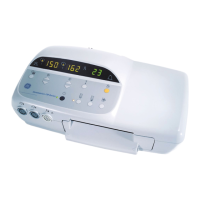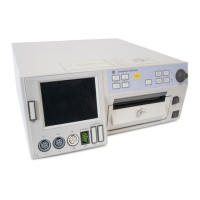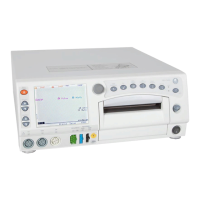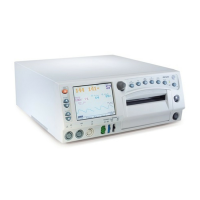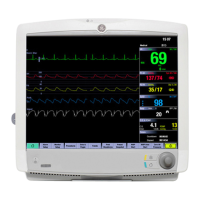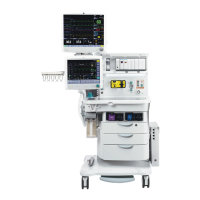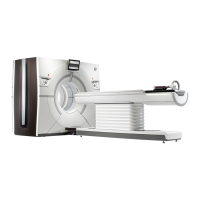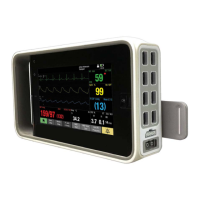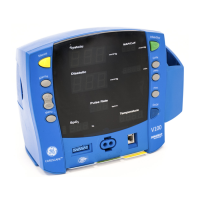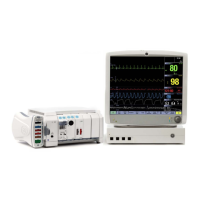5-28 170 Series Monitor Revision C
2000947-004
Theory of Operation: Main Board Theory of Operation
Ultrasound Oscillator
Internal gates located in integrated circuit U50, X4, and associated components
comprise a crystal-controlled oscillator running at 4.604 MHz. The inverted output
of this oscillator is the clock that is used to clock latch U48; therefore changes at the
outputs of U50 are not clocked out of U48 until one-half clock cycle later. The
system runs at a frequency of 2 kHz [(4.604 MHz/1151)/2=2 kHz] and the time for
each transmission and reception is 250 µs [(1/2000)/2=250 µs]. The signal
TRANS_BURST is a square wave at a frequency of 1.151 MHz. It is initiated four
clock cycles after the internal reset of the binary counter within U50 used to decode
the signals used by the ultrasound system and continues 428 clock cycles. The
signal DET_BURST1 is also a square waves at a frequency of 1.151 MHz. This
signal is output 640 clock cycles after reset, and continues up to 1020 clock cycles.
Pin Diode Circuitry
The signals PIN1 and PIN2, from PAL U50, turn on the appropriate switches of U47
so as to bias pin diodes D21 and D22 on; this in turn provides a low impedance path
for the Channel 1 transducer to the ultrasound transmitter and preamplifier. Diodes
D23 and D24 are biased off, providing a high impedance path to the ultrasound
transmitter and preamplifier for the Channel 2 transducer. The opposite of the above
is true when the Channel 2 transducer is activated.
Transmission/Reception
Integrated circuits U53, U54, and U55 are voltage regulators used to provide stable,
low-noise power supplies for the ultrasound receiver and transmitter. Transistor
Q11, inductor L1, and capacitor C208 form the ultrasound transmitter. Q11 is
driven by the signal TRANS_BURST. Inductor L2 and capacitors C209, C210, and
CV1 provide tuning for the transmitter output. The transmitter has a nominal output
impedance of 30 Ω, and can typically drive 4 V peak-to-peak into a 20 Ω load.
Transistors Q12, Q13, and Q14, and associated components, form the preamplifier.
Capacitors C213, C215, C229, and C216 provide power supply rejection for the
preamplifier. Inductor L3, along with capacitors C211 and C212, form a series
resonant tank circuit. This tank circuit provides a low impedance path for the
received signals from the transducer, and a voltage gain of approximately 28 dB.
The typical input impedance to this tank circuit is 30 Ωs.
Transistors Q12 and Q13 form a cascode amplifier. Transistor Q13 is a dual n-
channel field effect transistor connected in parallel. This parallel connection
provides an improvement of 3 dB in signal-to-noise ratio due to the gain doubling
and the noise adding in quadrature. Inductor L4 and capacitors C214 and CV3 form
a parallel resonant tank circuit with an impedance of approximately 17 kΩs. The
shunt impedance of resistors R388, R389, R390, R391, and R392 effectively lower
this impedance to 3.6 kΩ. The gain of the preamplifier is approximately 19 dB and
is defined by:
Rl/((1/(2*gm))+R386)= 3.6k/((1/.002)+200)
Transistor Q14 and transformer T1 provide a differential output for the preamplifier.
Diode D19 provides protection for Q13 and removes the low impedance tank circuit
L3 and C211, and C212 during transmission by shunting L3. Diode D20 provides
overload recovery for the preamplifier and voltage limiting to the demodulator
through Q14 and T1.

